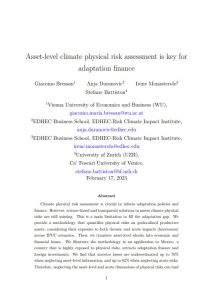

Asset-level climate physical risk assessment is key for adaptation finance
Climate physical risk assessment is crucial to inform adaptation policies and finance. However, science-based and transparent solutions to assess climate physical risk ...
Author(s):
Summary:
Climate physical risk assessment is crucial to inform adaptation policies and finance. However, science-based and transparent solutions to assess climate physical risks are still missing. This is a main limitation to fill the adaptation gap. The authors provide a methodology that quantifies physical risks on geolocalized productive assets, considering their exposure to both chronic and acute impacts (hurricanes) across IPCC scenarios. Then, they translate asset-level shocks into economic and financial losses. They illustrate the methodology in an application to Mexico, a country that is highly exposed to physical risks, attracts adaptation finance and foreign investments.
They find that investor losses are underestimated up to 70% when neglecting asset-level information, and up to 82% when neglecting acute risks. Therefore, neglecting the asset-level and acute dimensions of physical risks can lead to large errors in the identification of the relevant adaptation policy response and finance tools aimed to build resilience to climate change.
Keywords:
Climate physical risks, spatial finance, plant-level impact, tail risk, investors’ losses, adaptation
| Type : | Academic Publication |
|---|---|
| Date : | 21/03/2023 |

